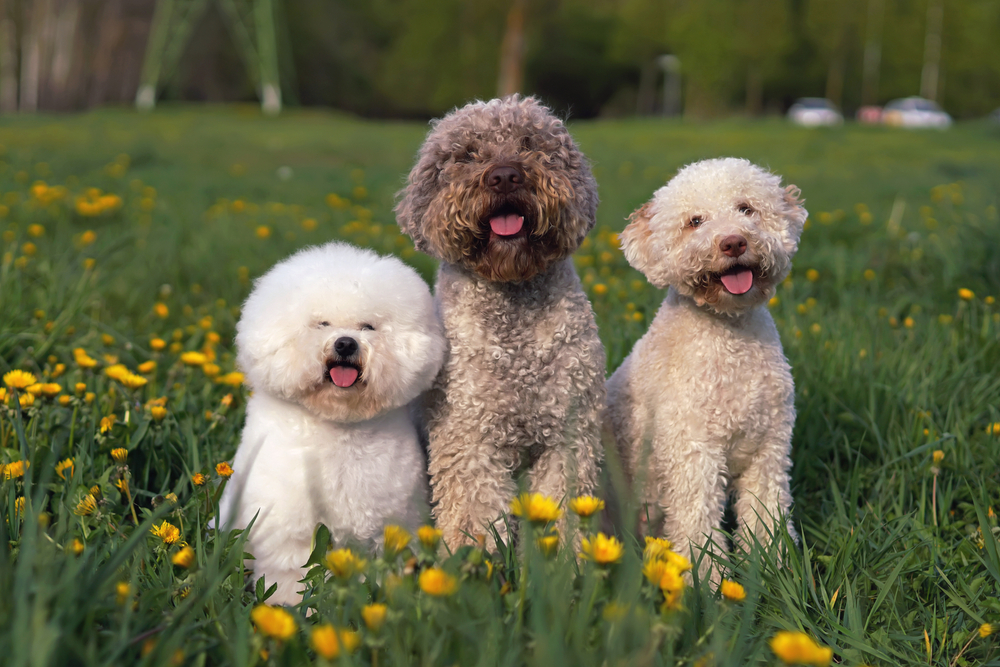Shedding canine companions can be frustrating for all of us, no matter how much we treasure them. All pooches shed to some degree, except for the completely hairless varieties.
Certain breeds, sometimes referred to as hypoallergenic dogs, shed very little, while others, such as the heavily double-coated breeds, shed large amounts continually.

Seasonal Shedding and Shedding Frequency
In general, most dogs will shed extra during spring and fall. Seasonal shedding occurs as a result of temperature change. This process is sometimes called “blowing coats.” When the weather warms, canines’ shed their old winter undercoats to make way for a lighter summer coat. Then, when the weather begins to cool again, they shed their lighter undercoats and grow thicker, warmer coats for winter. Seasonal shedding usually occurs over the course of two to three weeks.
Why Do Dogs Shed?
Shedding is a natural part of hair and fur growth. Dogs’ coats protect them from the elements and help regulate body temperature, so it’s important to have a coat that matches the season!
To better understand the frequency of shedding, it’s important to understand the difference between hair and fur. Dog hair and fur are both made out of keratin, the same protein that is present in fingernails, feathers, hooves, claws, and horns.
- Dog hair – is longer and goes through a slower growth cycle, which means it sheds less often.
- Dog fur – goes through a faster growth cycle and so sheds more heavily, which in turn, leads to the spread of dander.
Fur is more closely associated with the canine undercoat. Hair is the overcoat. Dogs tend to shed their fur seasonally. Hair is shed less frequently. Dogs with both fur and hair are called double-coated dogs. Most dog breeds are double-coated.
Hypoallergenic dogs usually, but not always, have a single coat made of hair rather than fur, which means they shed less frequently and therefore produce less dander than double-coated dogs.
Dog Breeds that Shed Less Frequently

The following breeds are most commonly associated with less shedding. Crossbreeds including any of the following may also shed less.
- Basenji
- Bedlington Terrier
- Bichon Frise
- Border Terrier
- Chinese Crested
- Coton de Tulear
- Havanese
- Irish Water Spaniel
- Kerry Blue Terrier
- Labradoodle
- Lagotto Romagnolo
- Lhasa Apso
- Maltese
- Poodle
- Portuguese Water Dog
- Puli
- Schnauzer
- Shih Tzu
- Soft Coated Wheaten Terrier
- Xoloitzcuintli
- Yorkshire Terrier
Why is My Hypoallergenic Dog Shedding?
Even dogs with a single coat of hair still shed. They just shed less frequently. Fur shedding is what is associated with seasonal shedding. When dogs shed hair, they tend to shed it periodically over time.
Generally, dogs without hair or with continuously growing hair and little to no fur tend to leave the least amount of dander in the environment. Therefore, these canines are known as hypoallergenic dogs. With many of these pooches, their hair will keep growing until it is cut or it dies. Because of this, if they are left ungroomed, they become a tangled mess. Regular and possibly frequent trips to the groomer are a must!
It’s Not Spring or Fall, But My Dog is Shedding a Lot. Why?
Canines that live indoors are subject to a temperature-controlled environment that can fool Mother Nature, causing changes to their natural shedding patterns. If your pooch does not go through a couple of phases of very heavy shedding over the course of the year, they probably fall into this category.
There are many other factors that can contribute to a dog shedding outside of seasonal shedding.
Full List of Factors that Influence Dog Shedding
- Seasonal temperature changes trigger seasonal shedding
- Lifestyle – indoor vs. outdoor animals
- Nutrition – poor nutrition can lead to hair loss
- Breed
- Gender – spayed and neutered dogs can have more pronounced undercoats, so shedding can be more noticeable
- Age
- Hormonal status can determine hair growth phases
- Behavior
- Health conditions – skin problems due to parasites, allergies or infection, endocrine diseases such as hypothyroidism, metabolic disorders, and organ dysfunction may all lead to hair loss
- Pregnancy
- Medications – prednisone or other corticosteroids impact shedding
- You – regularly grooming is important to reduce shedding
How to Reduce Dog Shedding
As you may have suspected by now, there are no cures for shedding. Oh, bah humbug, you say? Since shedding is a healthy and natural process, let’s review some reasons to spend time grooming your plucky pooch and tips to possibly decrease the shedding of mass quantities of hair and fur.
First, take your love bug to your veterinarian to rule out a possible underlying medical cause that may contribute to excess shedding.
Grooming Tips

- Consider regular grooming, so you can control when your dog will ‘lose’ hair. Put a reminder for yourself on your calendar.
- If you are using a wire brush or curry brush, make the session a positive experience, and pair brushing with a treat! Your pup will love the extra attention. Start at the head, and work your way down her back. Remember, every bit of hair and fur you collect on a brush is one less bit of fluff in your environment.
- Brush first, then de-shed using a shedding rake/de-shedding comb that has a small razor blade to help with mats and hair thinning.
- Use a metal-tined flea comb on the shorter-coated dogs. This can be a bit more intense, so go slow. You will have a grand harvest of fuzz!
- Regularly bathe your pooch with a soothing pH-balanced mild oatmeal shampoo. The act of bathing will loosen the hairs. Follow with a conditioner of the same type.
Diet and Supplement Tips
- Feed your dog high-quality, highly digestible protein. Hair is primarily protein, so high-quality food helps dog hair to stay in a long time rather than die and fall out.
- Vary your dog’s diet: not just a good, low-to-no carbohydrate kibble, but get some real foods involved. Of course, a gradual shift to ‘real’ food would also be wonderful. Learn more about varying your pup’s diet.
- Supplement your furry friend’s diet with additional essential fatty acids. Fish oils are the primary source of Omega 3 Fatty acids; however, there is a concern about mercury. Look for mercury-free fish oil. Flax oil is almost as good. Both of these essential fatty acids can decrease allergic symptoms and inflammation. Flax oil can be given at 1,000 mg per 10 pounds of body weight. The total dose amount can be divided into halves and given twice per day.
- Use coconut oil in their food or even rub it into your dog’s coat. Coconut oil is naturally antibacterial and antifungal, and it is a most excellent moisturizer.
- Curcuminoids, chemical compounds found in turmeric, can be given for underlying allergies and inflammation. The daily recommended dose is 100mg per every 10 pounds per body weight. If given twice per day, the total amount can be divided into halves.
- Add B vitamins to the diet. Visit your local holistic veterinarian for ideas and dosage information.
- Antioxidants, vitamin A and vitamin C are great anti-inflammatory supplements.
- Molasses is high in B vitamins and iron. Both of these are wonderful for your dog friend’s skin.
- Be sure your dog has enough moisture. He needs hydration from intaking clean water. One of my pet peeves is feeding dry kibble. Don’t do that to your dog! Add water or broth to dry kibble, and allow it to sit for 15 to 20 minutes so it is soft. Also, canned food and homemade food will have plenty of moisture.

There’s a reason your four-legged love muffin is such a joy to touch and snuggle with. That delightful hairdo they sport is what has us do a double-take and lures us in for the repeat caresses and attention. On the flip side, what grows in must come out, eventually!

